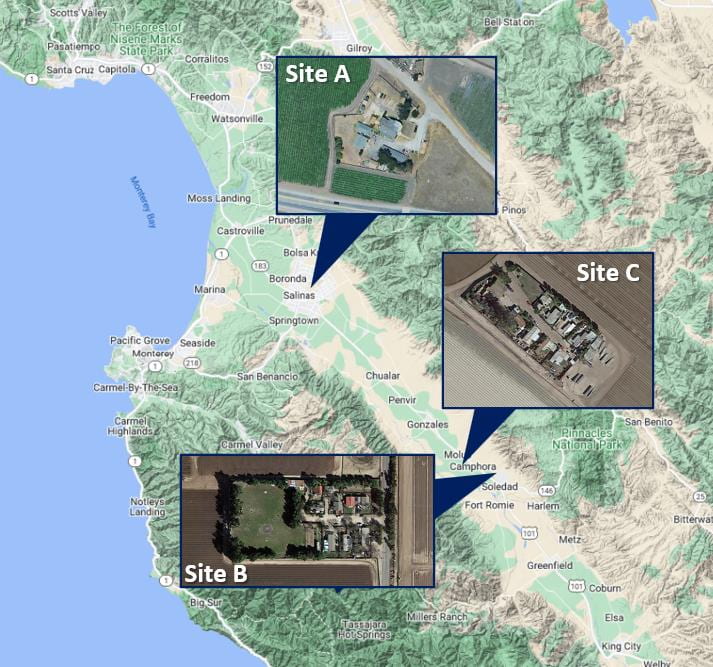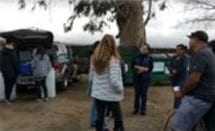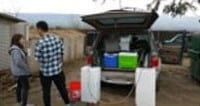Technology Deployment (Salinas Project)
Project Overview
(most importantly) safe source of potable water.
Project Goals
- Develop a reliable and affordable option for supplying safe drinking water to disadvantaged communities (DACs) where consolidation or alternate local well(s) are infeasible/impractical.
- To demonstrate that geographically separate but virtually networked (autonomous but remotely monitored/operated) treatment systems can be operated in several communities with economies of scale at affordable operated costs.
- Work with Regional Board to:
- Demonstrate septic tank suitability for residuals discharge from water treatment systems in small rural DACs.
Pilot Community Characteristics

Community Outreach: 2015 – 2021



Background
This project addresses the widespread problem of nitrate contamination and elevated salinity in small community water systems, particularly in rural, agricultural regions. Nitrate pollution, stemming from agricultural activities like fertilization, confined animal feeding operations, and septic systems, poses a significant threat to potable water sources. In California, over 200 community water systems have been reported to exceed the maximum contaminant levels (MCL) for nitrates, and elevated salinity has further degraded water quality. The Salinas Valley, for example, has seen some wells exceed nitrate levels by more than tenfold the legal limit. These contaminants are not just a local issue but a national concern, with water systems across the U.S. reporting similar challenges.
For small, disadvantaged communities (DACs), addressing water contamination is particularly difficult. These communities often rely on their own wells and water distribution systems and are disconnected from larger, centralized water infrastructure. With limited financial resources, they struggle to afford the high costs associated with water treatment or replacement. In response, California has provided interim measures such as subsidies for bottled or trucked water, but long-term solutions remain critical. Potential permanent solutions include drilling new wells or consolidating smaller water systems with larger, nearby ones that have uncontaminated water supplies. However, both options come with logistical and financial challenges, such as high infrastructure costs and a lack of consistent policy support.
Water treatment technologies like reverse osmosis (RO) and ion exchange (IX) are central to the project’s approach. Reverse osmosis, a membrane-based technology, is effective for both nitrate removal and reducing salinity, providing broad protection against multiple contaminants. RO systems have proven highly efficient, rejecting up to 96% of nitrates, making them ideal for areas where contamination levels are significantly above safe thresholds. However, RO systems produce a residual waste stream that must be managed, which adds complexity, particularly for small communities without access to municipal wastewater treatment facilities. Ion exchange offers an alternative solution for communities with lower nitrate levels but comes with its own set of challenges, including the need for frequent regeneration and potential environmental impacts from salt disposal.
The project introduces Distributed Smart Water Treatment (DSWT) systems as an innovative, scalable solution. These systems are designed to be autonomous and adaptable, capable of being remotely monitored and controlled via an advanced cyberinfrastructure. This allows for proactive maintenance, operational adjustments, and system oversight without requiring full-time, onsite personnel. DSWT systems transmit real-time data to centralized servers, enabling efficient management across geographically dispersed communities. This technology is critical for small rural areas, where there is often a shortage of skilled water treatment operators and the cost of hiring experts is prohibitive. By using DSWT systems, the project aims to ensure reliable, long-term water treatment in areas where conventional solutions are not feasible.
One of the most challenging aspects of the project is the management of residual waste from RO systems. The project proposes an innovative solution: discharging the RO residual stream into community septic systems, where the nitrate undergoes denitrification under anaerobic conditions. This method, successfully demonstrated in pilot communities, has received regulatory approval in California, providing a practical approach for reducing nitrate discharge into the environment. By managing the waste stream locally, the project addresses one of the most significant barriers to implementing advanced water treatment systems in small, rural communities. This strategy helps to meet environmental standards, such as the U.S. EPA’s Anti-Degradation Policy, while minimizing costs and infrastructure needs for communities dependent on septic systems.
System Development
The Distributed Smart Water Treatment (DSWT) systems were developed using reverse osmosis (RO) technology to deliver efficient and decentralized water treatment for small communities. Each system was designed to treat well water by reducing nitrate and salinity levels to meet safe drinking water standards. The design process included integrating pre- and post-treatment units, ensuring that the system could be remotely monitored and controlled using programmable logic controllers (PLCs). This allowed for adaptive functionality to respond to real-time operational constraints and local requirements.
Each DSWT system was constructed to be housed in a secure unit, with the treated water delivered through existing infrastructure. The systems were designed to fit seamlessly within the local environment, utilizing current water distribution and septic systems. Waste streams from the water treatment process were discharged into community septic tanks, where biological denitrification processes were implemented and monitored.
Once installed, the systems were tested and commissioned under the oversight of state and local authorities. The implementation process included rigorous water quality monitoring and real-time data collection through in-line sensors. Monthly performance reports were provided to relevant regulatory agencies to ensure ongoing compliance with water safety standards. The systems were successfully deployed in three communities in Salinas Valley, demonstrating the effectiveness of decentralized water treatment technologies in improving access to clean water.
2015 – 2019
- Informing the residents of the basic treatment technology
- Demonstrating the water treatment technology
- Respond to questions by the residents
- Coordinate scheduling of site visits to carry out various elements of the project work
- Informing the residents and owners regarding the project status project along its various stages
2020 – 2021
- The COVID-19 pandemic has impacted our Outreach Program more than any other part of the project
- In-person outreach has been postponed since the beginning of the COVID-19 Pandemic (~March 2020)
- The project team maintained communication with three owners regarding infrastructure upgrade by phone, Zoom, and in-person (adhering to PPE and social distancing guidelines).
It is crucial to re-energize the project outreach program in order to build confidence in the drinking water program.
Major Project Elements
- Determination of Community Water Consumption
- Water Treatment Design
- Design and implementation of a rigorous water quality
- Concentrate Management
Project Stakeholders
- UCLA Project Team
- Property owner
- Residents
- Greater Monterey Community
- State and local elected representatives
- State Water Resources Control Board, Division of Drinking Water
- Central Coaster Water Quality Control Board
- Monterey County Health Department, Environmental Health Department, Drinking Water Program
- Monterey County Resources Management Agency, Building Services Department
